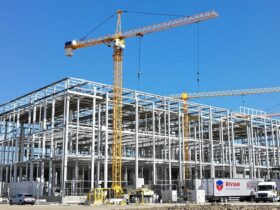Ford has decided to raise prices on three of its models, including the Maverick, Bronco Sport, and Mach-E. A move that many are attributing to the ongoing impact of tariffs put in place by Donald Trump. This decision comes as a surprise to some, especially after the company had previously indicated that it did not foresee any price increases this year. With the pressure from tariffs affecting their bottom line, Ford is adjusting its pricing strategy to cope with the changing market landscape.
Key Takeaways
- Ford is increasing prices on three models due to tariff pressures.
- The price hikes will range from $600 to $2,000, affecting vehicles made in Mexico.
- Trump’s tariffs are expected to cost Ford about $1.5 billion in profits this year.
- Consumer sentiment may shift as price increases could impact sales and trust in the brand.
- Ford’s pricing strategy reflects broader trends in the auto industry as other manufacturers also respond to tariffs.
Ford’s Price Increases Amid Tariff Pressures
Overview of Price Changes
Ford has recently announced price increases on select models, a move that comes amid ongoing trade tensions and tariffs imposed by the Trump administration. These adjustments reflect the financial pressures that Ford is experiencing due to increased import costs. The company had initially hoped to avoid raising prices, but the impact of the tariffs has made it necessary to adjust pricing strategies.
Affected Models
The price hikes primarily affect Ford models manufactured in Mexico. These include:
- Ford Maverick: Known as one of America’s most affordable pickup trucks.
- Ford Mustang Mach-E: An all-electric SUV.
- Ford Bronco Sport: A compact SUV.
These models are subject to tariffs on imported vehicles and auto parts, directly impacting Ford’s production costs. The Ford Maverick is particularly affected.
Expected Price Ranges
The suggested retail price increases are expected to range from $600 to $2,000 per vehicle. While Ford has absorbed some of the tariff costs, the company can no longer fully offset the financial burden. This adjustment will likely affect consumers looking for affordable options in Ford’s lineup.
Ford spokesman Said Deep stated, “This is our usual mid-year pricing actions combined with some tariffs we are facing… We have not passed on the full cost of tariffs to our customers. Our approach throughout this evolving situation continues to be doing what’s right for our customers—and our business.”
Impact of Trump Tariffs on Ford
Overview of Tariff Policies
The Trump administration implemented a series of tariffs, most notably on imported vehicles and auto parts. These tariffs, some as high as 25%, aimed to protect domestic industries and encourage manufacturing within the United States. The policy changes affected Ford’s supply chain and production costs, especially for vehicles and parts sourced from outside the U.S. These tariffs were a big deal for automakers who had gotten used to importing stuff without extra fees. It really shook things up.
Financial Implications for Ford
Ford publicly stated that the tariffs would likely reduce the company’s profits by a significant amount. One estimate put the potential profit reduction at around $1.5 billion for the year. This financial hit stemmed from increased costs of imported components and vehicles. Ford had to decide whether to absorb these costs, pass them on to consumers, or find ways to mitigate the impact through cost-cutting measures or supply chain adjustments. The company’s financial planning became a lot more complicated because of these tariffs. Ford’s tariff impact was substantial.
Market Reactions
The market reacted to Ford’s price increases with a mix of concern and understanding. Consumers faced higher prices on certain models, potentially impacting demand. Analysts closely watched Ford’s sales figures and market share to assess the long-term effects of the tariffs. Other automakers also faced similar pressures, leading to industry-wide discussions about pricing strategies and supply chain resilience. The tariffs created a lot of uncertainty in the auto market, and everyone was trying to figure out how to respond.
The tariffs forced Ford to re-evaluate its pricing and production strategies. The company had to balance the need to remain competitive with the rising costs of imported materials and components. This situation highlighted the interconnectedness of the global automotive industry and the potential consequences of trade policies.
Here’s a quick look at how the tariffs impacted prices:
- Increased production costs
- Higher vehicle prices for consumers
- Potential decrease in sales volume
- Shift in consumer preferences towards more affordable options
Consumer Reactions to Price Hikes
Public Sentiment
When car prices go up, people notice. It’s not exactly a secret. And when a company like Ford increases prices, especially citing tariffs, it tends to stir up some feelings. You see a lot of grumbling online, people questioning the value they’re getting, and generally just being unhappy about having to spend more money. The general mood is definitely not positive.
Impact on Sales
Do higher prices mean fewer sales? Usually, yeah. It’s pretty simple. Some people will still buy, because they need a car, or they really want that specific model. But others? They’ll start looking at cheaper options, maybe a used car, or a different brand altogether. It’s a balancing act for Ford. How much can they raise prices before sales really start to drop? It’s a tough question, and they’re probably watching the numbers very closely. Economists estimate car prices will increase between $2,000 and $15,000 per vehicle.
Long-term Consumer Trust
This is where it gets tricky. It’s not just about immediate sales; it’s about what people think of Ford down the road. If people feel like Ford is just passing on costs without trying to find other solutions, it can hurt their reputation. Trust is hard to earn, and easy to lose. Will people remember this price hike the next time they’re car shopping? Maybe. It depends on a lot of things, like how the economy is doing, what other brands are doing, and how Ford handles the situation overall.
It’s a gamble for Ford. They need to balance short-term profits with long-term customer loyalty. Price increases can erode consumer confidence, especially if people feel like they’re being taken advantage of. It’s a delicate situation, and how Ford navigates it will have a big impact on their future success.
Here are some factors that influence consumer trust:
- Transparency in pricing: Are they open about why prices are going up?
- Perceived value: Do people still feel like they’re getting a good deal?
- Customer service: How do they treat customers who are unhappy about the price increases?
Ford’s Strategy in Response to Tariffs
Adaptation Measures
Ford is actively working to lessen the impact of tariffs. This involves a multi-pronged approach. They’re looking at ways to shift production, renegotiate with suppliers, and find efficiencies within their existing operations. It’s a tough balancing act, trying to absorb some of the tariff costs while still delivering competitive prices to consumers. Ford has stated they are “well positioned to adapt to the changes tariffs are driving” in the industry.
Cost Management
Ford is really focused on keeping costs down. This isn’t just about tariffs; it’s about staying competitive in a changing market. They’re looking at everything from streamlining manufacturing processes to reducing material costs.
- Reducing waste in production.
- Negotiating better deals with suppliers.
- Investing in automation to improve efficiency.
Ford is trying to avoid passing the full cost of tariffs onto consumers. They’re trying to find ways to absorb some of those costs internally. This is a difficult challenge, but they’re committed to doing what’s right for their customers and their business.
Future Pricing Strategies
Ford’s future pricing strategies are going to be heavily influenced by the ongoing tariff situation. They’re likely exploring a range of options, from adjusting prices on specific models to shifting production to avoid tariffs altogether. It’s a fluid situation, and Ford will need to remain flexible to adapt to changing market conditions.
Here’s a possible scenario:
| Tariff Level | Potential Ford Response |
|---|---|
| Low | Absorb costs, minor price adjustments |
| Medium | Targeted price increases on affected models |
| High | Production shifts, significant price restructuring |
Comparison with Other Automakers
Industry-Wide Price Trends
It’s not just Ford feeling the pinch. Across the automotive industry, there’s been a noticeable upward trend in prices. Several factors contribute to this, including increased material costs, supply chain disruptions, and, of course, tariffs. Many automakers are quietly adjusting their pricing strategies to cope with these pressures. It’s becoming harder to find a new car at pre-tariff prices, regardless of the brand.
Competitor Responses
How are Ford’s competitors reacting? Some are absorbing the tariff costs to maintain competitive pricing, at least for now. Others are shifting production locations or renegotiating supplier contracts. Still others are passing the costs directly to consumers, similar to Ford’s approach. Here’s a quick look at some strategies:
- Company A: Absorbing tariff costs on select models to maintain market share.
- Company B: Shifting some production to the U.S. to avoid tariffs.
- Company C: Increasing prices across their entire lineup.
It’s a mixed bag out there. No one wants to be the first to raise prices significantly, but everyone is feeling the squeeze. The long-term effects on consumer behavior are still uncertain.
Market Share Implications
These price adjustments could have a significant impact on market share. If Ford’s price increases are more substantial than its competitors’, it could lose customers to brands that offer similar vehicles at lower prices. Conversely, if competitors follow suit, the entire market could see a shift in consumer preferences, potentially favoring more affordable or smaller vehicles. The most affordable pickup might not be the most affordable for long. It’s a delicate balancing act, and only time will tell how it all shakes out. The impact of Trump’s tariffs is definitely being felt.
Economic Factors Influencing Ford’s Pricing
Inflation and Consumer Confidence
Inflation is a big deal. When the cost of everything goes up, Ford has to think about raising prices too. Consumer confidence plays a role as well. If people feel good about the economy, they’re more likely to buy a new car, even if it costs a bit more. If people are worried about their jobs or the future, they might hold off on big purchases, which puts pressure on Ford to keep prices down or offer incentives. Ford has to balance these factors to stay competitive and profitable.
Supply Chain Challenges
Getting all the parts needed to build a car is a complex operation. If there are disruptions in the supply chain – say, a shortage of semiconductors or a port closure – it can drive up costs. Ford might have to pay more for parts or spend more to get them delivered faster. These increased costs can then be passed on to consumers in the form of higher prices.
- Raw material costs (steel, aluminum, rubber)
- Component shortages (semiconductors)
- Shipping and logistics expenses
Global Market Dynamics
The global auto market is huge and competitive. What happens in other countries can affect Ford’s pricing strategy. For example, if the value of the dollar changes relative to other currencies, it can make Ford’s cars more or less expensive in those markets. Also, trade agreements and tariffs can have a big impact. If Ford has to pay tariffs on imported parts or vehicles, that will likely increase prices for consumers. Ford’s truck lineup is affected by these global dynamics.
Ford operates in a global marketplace, and its pricing decisions are influenced by a complex web of economic factors. These include not only domestic conditions like inflation and consumer confidence but also international dynamics such as currency fluctuations, trade policies, and supply chain stability. Successfully navigating these challenges is crucial for Ford to maintain its competitiveness and profitability.
Ford’s Manufacturing Locations and Tariff Impact
U.S. vs. Mexican Production
Ford has a significant manufacturing footprint in both the United States and Mexico. The U.S. plants generally focus on higher-volume models and those targeted at the domestic market. Mexican plants, on the other hand, often produce smaller vehicles or components, some of which are then exported to the U.S. or other countries. This split in production is now a key factor in how tariffs affect Ford’s bottom line.
Tariff Effects on Different Models
Tariffs impact models made in Mexico more directly. For example, the Ford Maverick, Bronco Sport, and Mustang Mach-E, all produced in Mexico, have seen price increases. Models primarily manufactured in the U.S. are less affected, though they can still be impacted by tariffs on imported parts. The Ford Maverick is known as America’s most affordable pickup.
Logistical Considerations
Moving parts and vehicles across borders involves complex logistics. Tariffs add to these complexities, requiring Ford to re-evaluate its supply chains and distribution networks. This can involve finding alternative suppliers, adjusting production schedules, or even shifting manufacturing locations in the long term. These changes can lead to increased costs and potential delays. Ford is trying to implement cost management to offset these issues.
Ford is trying to minimize the impact of tariffs on consumers. The company has stated that it hasn’t passed on the full cost of tariffs to its customers, but some price increases are unavoidable. The company is trying to adapt to the changes tariffs are driving in the industry.
Here’s a simplified view of how tariffs can affect different models:
- Mexican-Made Models: Higher tariffs, direct price increases.
- U.S.-Made Models (with imported parts): Moderate tariff impact, potential price increases.
- U.S.-Made Models (mostly domestic parts): Lower tariff impact, minimal price changes.
Historical Context of Tariffs in the Auto Industry
Previous Tariff Impacts
Tariffs have a long and complicated history in the auto industry. Way back when, tariffs were often used to protect fledgling domestic industries from foreign competition. The idea was to give local manufacturers a chance to grow and become competitive without being undercut by cheaper imports. For example, in the early 20th century, the U.S. used tariffs to support the growth of its own auto industry. These tariffs definitely helped companies like Ford and GM get a foothold, but they also meant consumers paid more for cars. It’s a balancing act – protect local jobs versus higher prices for consumers. The impact of these tariffs on car prices was significant, often leading to increased costs for consumers.
Lessons from Past Policies
Looking back, there are some clear lessons to be learned from previous tariff policies. First, tariffs can lead to retaliatory measures from other countries, sparking trade wars that hurt everyone involved. Second, while tariffs might protect some jobs in the short term, they can also stifle innovation and make domestic industries less competitive in the long run. Companies might become reliant on protectionism instead of focusing on improving efficiency and quality. Third, the effects of tariffs are rarely uniform. Some companies and sectors benefit, while others suffer. For instance, a tariff on imported steel might help U.S. steel producers but hurt auto manufacturers who rely on that steel. It’s a complex web of interconnected effects. Here’s a quick look at some historical tariff impacts:
| Tariff Target | Impact on US Auto Industry | Impact on Consumers |
|---|---|---|
| Imported Steel | Increased production costs | Higher car prices |
| Foreign Vehicles | Protected domestic manufacturers | Reduced consumer choice |
| Auto Parts | Disrupted supply chains | Delays in production |
Current Trends in Tariff Legislation
Right now, we’re seeing a resurgence of protectionist sentiment, with countries around the world imposing new tariffs and trade barriers. The auto industry is right in the middle of it all. The Trump administration’s tariffs on imported steel and aluminum, as well as vehicles and auto parts from certain countries, have had a major impact. These tariffs were intended to boost domestic manufacturing and reduce the trade deficit, but they’ve also led to higher costs for automakers and consumers. It’s a situation where the long-term consequences are still unfolding. The industry has been relatively supportive of Trump’s tariff scheme, and manufacturers have been slow to peg price increases to the president’s economic policies. But now not even Ford, the pride and joy of the American auto industry, can keep up the facade.
The current trend in tariff legislation is characterized by uncertainty and volatility. Trade agreements are being renegotiated, and new tariffs are being threatened or imposed on a regular basis. This makes it difficult for automakers to plan for the future and invest in new technologies. The industry is calling for more stable and predictable trade policies to ensure its long-term competitiveness.
Here are some key trends:
- Increased use of tariffs as a negotiating tactic.
- Growing concerns about the impact of tariffs on global supply chains.
- Calls for more balanced and reciprocal trade agreements.
Future Outlook for Ford and Tariffs
Predictions for Pricing
The crystal ball is always a bit hazy, but most analysts think Ford’s pricing will remain sensitive to tariff changes. If tariffs stay high or increase, consumers can probably expect to see those costs passed down. If there’s a rollback, there might be some price relief, but don’t hold your breath. Ford will likely try to balance profitability with maintaining a competitive edge. The institutional interest in Ford’s stock will also play a role in how they navigate these pricing decisions.
Potential Policy Changes
Trade policy is a political football, so anything can happen. A new administration could scrap the existing tariffs, modify them, or even introduce new ones. Ford, like other automakers, is probably lobbying hard behind the scenes to get favorable treatment. It’s a waiting game to see how these policies will evolve and how they will affect the most affordable pickup trucks.
Long-term Industry Effects
Tariffs aren’t just a short-term headache; they can reshape the entire auto industry. Here are some potential long-term effects:
- Supply Chain Shifts: Automakers might rethink where they source parts and assemble vehicles to avoid tariffs.
- Manufacturing Investments: There could be more investment in U.S. manufacturing if tariffs make it cheaper to produce here.
- Innovation Focus: Companies might prioritize developing more fuel-efficient or electric vehicles to offset higher costs.
The long-term effects of tariffs on the auto industry are complex and multifaceted. They could lead to significant shifts in manufacturing locations, supply chain strategies, and even the types of vehicles that automakers choose to produce. The industry will need to remain agile and adaptable to navigate these changes successfully.
It’s a complex situation, and Ford’s future is closely tied to these broader economic and political forces. The company’s ability to adapt and innovate will be key to its long-term success.
Final Thoughts on Ford’s Price Hike
In the end, Ford’s decision to raise prices on its Mexican-made models shows just how much pressure the tariffs are putting on the auto industry. Even a big player like Ford can’t escape the impact of these trade policies. Customers are going to feel the pinch, especially with the Maverick being labeled as the most affordable pickup. It’s a tough spot for consumers who are already dealing with rising costs everywhere. As the situation unfolds, it’ll be interesting to see how Ford and other manufacturers adapt to these challenges and what it means for car buyers in the long run.
Frequently Asked Questions
Why is Ford raising prices on certain models?
Ford is increasing prices due to tariffs imposed by the Trump administration, which are affecting the cost of foreign-made vehicles.
Which Ford models are getting price increases?
The price hikes will affect three models made in Mexico: the Ford Mustang Mach-E, the Maverick, and the Bronco Sport.
How much will the prices go up?
The price increases are expected to range from $600 to $2,000 per vehicle.
When will these price changes take effect?
The new prices are set to start on May 2.
How are tariffs impacting Ford’s profits?
Ford estimates that the tariffs could reduce its profits by about $1.5 billion this year.
What is the general public reaction to these price hikes?
Consumers are frustrated, as these increases come at a time when many are already feeling the effects of rising costs.
How is Ford planning to manage costs in response to tariffs?
Ford is working on adapting its strategies to manage costs and maintain its business while dealing with the impact of tariffs.
Are other car companies also raising prices?
Yes, many other automakers are facing similar pressures and are likely to increase prices as well.













Leave a Reply